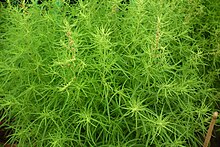Bassia scoparia
| Bassia scoparia | |
|---|---|

| |
| Scientific classification | |
| Kingdom: | |
| (unranked): | |
| (unranked): | |
| (unranked): | |
| Order: | |
| Family: | |
| Subfamily: | |
| Genus: | |
| Species: | B. scoparia
|
| Binomial name | |
| Bassia scoparia | |
| Synonyms | |
|
Kochia scoparia (L.) Schrad. | |
Bassia scoparia (syn. Kochia scoparia) is a large annual herb in the family Amaranthaceae native to Eurasia.[1] It has been introduced to many parts of North America,[2] where it is found in grassland, prairie, and desert shrub ecosystems.[1] Its common names include burningbush,[2] ragweed, summer cypress,[1] mock-cypress, kochia, belvedere, Mexican firebrush, and Mexican fireweed.[3]
Biology
The seed of Bassia scoparia is dispersed by wind and water, and it is transported when the whole plant detaches and rolls on the wind as a tumbleweed.[1] The seed does not persist in the soil seed bank, dying within about a year if it fails to germinate.[1]
The species is a C4 plant, specifically of the NADP-ME type.[4][5]
Uses
This plant is grown as an ornamental for its red fall foliage. It has also been useful in erosion control on denuded soils.[6] It has been suggested as an agent of phytoremediation,[6] because it is a hyperaccumulator of chromium, lead, mercury, selenium, silver, zinc,[7] and uranium.[8] Bassia scoparia contains higher levels of protein and oxalate than most grasses and fodder plants, thus it also serves as a good forage crop for livestock. When grown as ornamental plant, it is a good choice as evergreen foliage plant for landscapes.[9]
Tonburi
In Japan the seeds are used a food garnish called tonburi (とんぶり) (Japanese). Because its texture is similar to caviar, it has been called "land caviar", "field caviar", and "mountain caviar". It is a chinmi, or delicacy, in Akita prefecture. The glossy, greenish black seeds are dried, boiled, soaked, and then rubbed by hand to remove the skin.
Traditional medicine
The seeds are used in traditional Chinese medicine to help regulate disorders such as hyperlipidemia, hypertension, obesity, and atherosclerosis. In a study of mice fed a high-fat diet, an extract of the seeds limited obesity.[10] They contain momordin Ic, a triterpene saponin.[11]
Forage
The plant is a moderately useful forage for livestock, especially on dry lands.[12] However, its use is limited by its toxicity in large quantities.[13] Livestock ingesting large amounts can experience weight loss, hyperbilirubinemia, photosensitization, and polyuria.[14]
Systematics
The species was first published in 1753 by Carl Linnaeus, who named it Chenopodium scoparium. In 1809, it was placed in the genus Kochia by Heinrich Schrader. It was transferred to Bassia in 1978 by Andrew John Scott. Kochia was included in Bassia in 2011 following phylogenetic studies.[4]
Gallery
This section contains an unencyclopedic or excessive gallery of images. |
-
Form
-
Inflorescence
-
As a weed
-
Ornamental planting
-
Tonburi
-
Mass planting at Hitachi Seaside Park, Japan.
References
- ^ a b c d e Kochia scoparia. USFS Fire Effects Information System.
- ^ a b Bassia scoparia. USDA PLANTS. Retrieved October 19, 2007.
- ^ "USDA GRIN taxonomy".
- ^ a b Kadereit, Gudrun; Freitag, Helmut (2011). "Molecular phylogeny of Camphorosmeae (Camphorosmoideae, Chenopodiaceae): Implications for biogeography, evolution of C4-photosynthesis and taxonomy". Taxon. 60 (1): 51–78.
- ^ Muhaidat R, Sage RF, Dengler NG (March 2007). "Diversity of Kranz anatomy and biochemistry in C4 eudicots". American Journal of Botany. 94 (3): 362–81. doi:10.3732/ajb.94.3.362. PMID 21636407.
{{cite journal}}: CS1 maint: multiple names: authors list (link) - ^ a b Casey, P.A. (2009). "Plant guide for kochia (Kochia scoparia)" (PDF). Manhattan, Kansas: USDA Natural Resources Conservation Service, Kansas Plant Materials Center.
- ^ McCutcheon; Schnoor (2003). Phytoremediation. New Jersey: John Wiley & Sons.[page needed]
- ^ Schmidt U (2003). "Enhancing phytoextraction: the effect of chemical soil manipulation on mobility, plant accumulation, and leaching of heavy metals". Journal of Environmental Quality. 32 (6): 1939–54. doi:10.2134/jeq2003.1939. PMID 14674516.
- ^ "Kochia Scoparia". The Lovely Plants. Retrieved 13 July 2014.
- ^ Han LK, Nose R, Li W; et al. (October 2006). "Reduction of fat storage in mice fed a high-fat diet long term by treatment with saponins prepared from Kochia scoparia fruit". Phytotherapy Research. 20 (10): 877–82. doi:10.1002/ptr.1981. PMID 16892459.
{{cite journal}}: CS1 maint: multiple names: authors list (link) - ^ Matsuda H, Li Y, Yamahara J, Yoshikawa M (May 1999). "Inhibition of gastric emptying by triterpene saponin, momordin Ic, in mice: roles of blood glucose, capsaicin-sensitive sensory nerves, and central nervous system". The Journal of Pharmacology and Experimental Therapeutics. 289 (2): 729–34. PMID 10215646.
{{cite journal}}: CS1 maint: multiple names: authors list (link) - ^ Rankins DL, Smith GS, Hallford DM (July 1991). "Serum constituents and metabolic hormones in sheep and cattle fed Kochia scoparia hay". Journal of Animal Science. 69 (7): 2941–6. PMID 1885403.
{{cite journal}}: CS1 maint: multiple names: authors list (link) - ^ Rankins DL, Smith GS, Hallford DM (September 1991). "Effects of metoclopramide on steers fed Kochia scoparia hay". Journal of Animal Science. 69 (9): 3699–705. PMID 1938652.
{{cite journal}}: CS1 maint: multiple names: authors list (link) - ^ Rankins DL, Smith GS, Hallford DM (July 1991). "Altered metabolic hormones, impaired nitrogen retention, and hepatotoxicosis in lambs fed Kochia scoparia hay". Journal of Animal Science. 69 (7): 2932–40. PMID 1885402.
{{cite journal}}: CS1 maint: multiple names: authors list (link)







